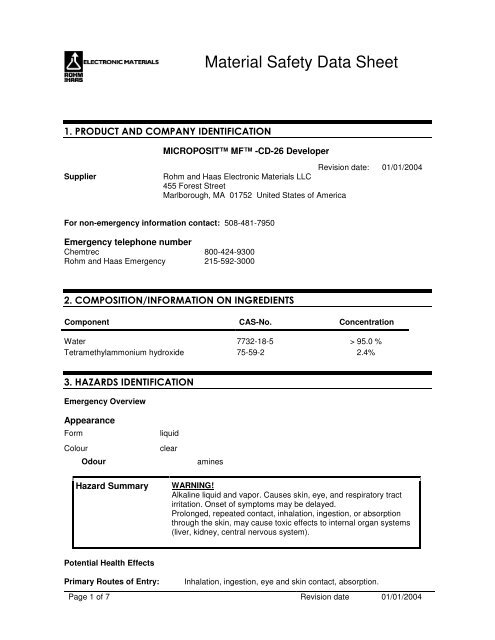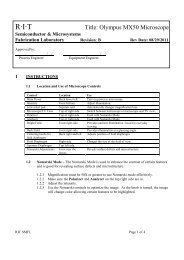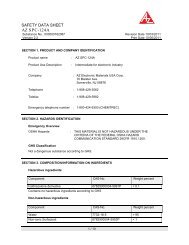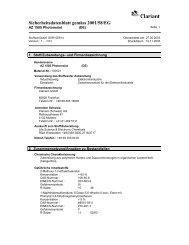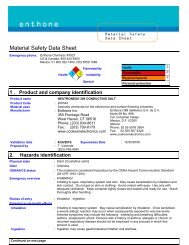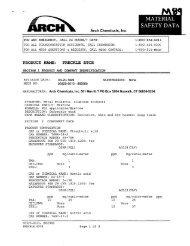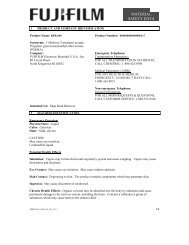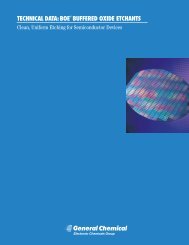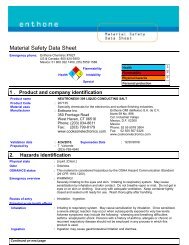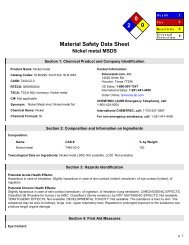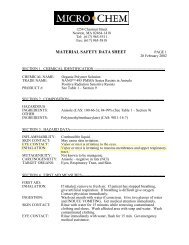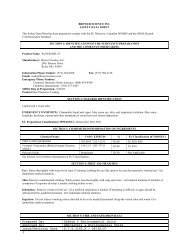MICROPOSIT™ MF™ -CD-26 Developer
MICROPOSIT™ MF™ -CD-26 Developer
MICROPOSIT™ MF™ -CD-26 Developer
Create successful ePaper yourself
Turn your PDF publications into a flip-book with our unique Google optimized e-Paper software.
Material Safety Data Sheet<br />
1. PRODUCT AND COMPANY IDENTIFICATION<br />
MICROPOSIT MF -<strong>CD</strong>-<strong>26</strong> <strong>Developer</strong><br />
Supplier<br />
Revision date: 01/01/2004<br />
Rohm and Haas Electronic Materials LLC<br />
455 Forest Street<br />
Marlborough, MA 01752 United States of America<br />
For non-emergency information contact: 508-481-7950<br />
Emergency telephone number<br />
Chemtrec 800-424-9300<br />
Rohm and Haas Emergency 215-592-3000<br />
2. COMPOSITION/INFORMATION ON INGREDIENTS<br />
Component CAS-No. Concentration<br />
Water 7732-18-5 > 95.0 %<br />
Tetramethylammonium hydroxide 75-59-2 2.4%<br />
3. HAZARDS IDENTIFICATION<br />
Emergency Overview<br />
Appearance<br />
Form<br />
Colour<br />
Odour<br />
liquid<br />
clear<br />
amines<br />
Hazard Summary<br />
WARNING!<br />
Alkaline liquid and vapor. Causes skin, eye, and respiratory tract<br />
irritation. Onset of symptoms may be delayed.<br />
Prolonged, repeated contact, inhalation, ingestion, or absorption<br />
through the skin, may cause toxic effects to internal organ systems<br />
(liver, kidney, central nervous system).<br />
Potential Health Effects<br />
Primary Routes of Entry: Inhalation, ingestion, eye and skin contact, absorption.<br />
Page 1 of 7 Revision date 01/01/2004
MICROPOSIT(TM) MF(TM) -<strong>CD</strong>-<strong>26</strong> <strong>Developer</strong><br />
Eyes: May cause pain, transient irritation and superficial corneal effects.<br />
Skin: Material may cause irritation.<br />
Prolonged or repeated exposure may have the following effects:<br />
central nervous system depression<br />
drowsiness<br />
defatting of skin leading to irritation and dermatitis<br />
Ingestion: Swallowing may have the following effects:<br />
irritation of mouth, throat and digestive tract<br />
Repeated doses may have the following effects:<br />
central nervous system depression<br />
drowsiness<br />
Inhalation: Inhalation may have the following effects:<br />
irritation of nose, throat and respiratory tract<br />
Higher concentrations may have the following effects:<br />
systemic effects similar to those resulting from ingestion<br />
Target Organs: Eye<br />
Respiratory System<br />
Skin<br />
nervous system<br />
Carcinogenicity<br />
Not considered carcinogenic by NTP, IARC, and OSHA<br />
4. FIRST AID MEASURES<br />
Inhalation: Remove from exposure. If there is difficulty in breathing, give oxygen. Seek medical<br />
attention if symptoms persist.<br />
Skin contact: Wash skin with water. Continue washing for at least 15 minutes. Obtain medical<br />
attention if blistering occurs or redness persists.<br />
Eye contact: Immediately flush the eye with plenty of water for at least 15 minutes, holding the eye<br />
open. Obtain medical attention if soreness or redness persists.<br />
Ingestion: Wash out mouth with water. Have victim drink 1-3 glasses of water to dilute stomach<br />
contents. Immediate medical attention is required Never administer anything by mouth if a victim is<br />
losing conciousness, is unconcious or is convulsing.<br />
Notes to physician<br />
Treat symptomatically.<br />
5. FIRE-FIGHTING MEASURES<br />
Flash point<br />
Lower explosion limit<br />
Upper explosion limit<br />
Nonflammable<br />
not applicable<br />
not applicable<br />
Page 2 of 7 Revision date 01/01/2004
MICROPOSIT(TM) MF(TM) -<strong>CD</strong>-<strong>26</strong> <strong>Developer</strong><br />
Suitable extinguishing<br />
media:<br />
Not readily combustible.<br />
Select extinguishing agent appropriate to other materials involved.<br />
Specific hazards during fire fighting: No specific measures necessary.<br />
Special protective equipment for fire-fighters: Wear full protective clothing and self-contained<br />
breathing apparatus.<br />
Further information: This product may give rise to hazardous vapors in a fire.<br />
6. ACCIDENTAL RELEASE MEASURES<br />
Personal precautions<br />
Wear suitable protective clothing.<br />
Environmental precautions<br />
Prevent the material from entering drains or water courses.<br />
Do not discharge directly to a water source.<br />
Advise Authorities if spillage has entered watercourse or sewer or has contaminated soil or vegetation.<br />
Methods for cleaning up<br />
Cover with absorbent or contain. Collect and dispose.<br />
7. HANDLING AND STORAGE<br />
Handling<br />
Use only in well-ventilated areas. Avoid breathing vapor. Avoid contact with eyes, skin and clothing.<br />
Keep container tightly closed.<br />
Further information on storage conditions: No special precautions necessary.<br />
Storage<br />
Storage conditions: Store in original container. Storage area should be: cool dry well ventilated<br />
out of direct sunlight away from incompatible materials<br />
8. EXPOSURE CONTROLS / PERSONAL PROTECTION<br />
Exposure limit(s)<br />
Exposure limits are listed below, if they exist.<br />
Eye protection: goggles<br />
Hand protection: Butyl rubber gloves. Other chemical resistant gloves may be recommended by your<br />
safety professional.<br />
Skin and body protection: Normal work wear.<br />
Page 3 of 7 Revision date 01/01/2004
MICROPOSIT(TM) MF(TM) -<strong>CD</strong>-<strong>26</strong> <strong>Developer</strong><br />
Respiratory protection: Respiratory protection if there is a risk of exposure to high vapor<br />
concentrations. The specific respirator selected must be based on the airborne concentration found in<br />
the workplace and must not exceed the working limits of the respirator.<br />
Engineering measures: Engineering methods to prevent or control exposure are preferred.<br />
Methods include process or personnel enclosure, mechanical ventilation (local exhaust), and control of<br />
process conditions.<br />
9. PHYSICAL AND CHEMICAL PROPERTIES<br />
Appearance<br />
Form<br />
liquid<br />
Colour<br />
clear<br />
Odour<br />
amines<br />
pH 13<br />
Boiling point/range<br />
100 °C (212 °F)<br />
Flash point<br />
Nonflammable<br />
Lower explosion limit<br />
not applicable<br />
Upper explosion limit<br />
not applicable<br />
Vapour pressure<br />
Similar to water<br />
Component: Tetramethylammonium hydroxide<br />
Vapour pressure 17.5 mmHg at 20 °C<br />
Relative vapour density no data available<br />
Water solubility<br />
completely soluble<br />
Relative density 1.00<br />
Evaporation rate<br />
Slower than ether<br />
VOC's<br />
not applicable<br />
NOTE: The physical data presented above are typical values and should not be construed as a<br />
specification.<br />
10. STABILITY AND REACTIVITY<br />
Hazardous reactions<br />
Stable under normal conditions.<br />
Conditions to avoid<br />
Materials to avoid<br />
Hazardous<br />
decomposition<br />
products<br />
polymerization<br />
contact with incompatible materials<br />
Strong oxidizing agents acids<br />
triethylamine, nitrogen oxides (NOx), oxides of carbon, Methanol,<br />
Will not occur.<br />
Page 4 of 7 Revision date 01/01/2004
MICROPOSIT(TM) MF(TM) -<strong>CD</strong>-<strong>26</strong> <strong>Developer</strong><br />
11. TOXICOLOGICAL INFORMATION<br />
Toxicological information on this product or its components appear in this section when such data is<br />
available.<br />
Component: Tetramethylammonium hydroxide<br />
Acute dermal toxicity 2.1 %(m)<br />
A single 4h semi-occlusive application to intact rabbit skin produced no<br />
signs of dermal irritation.<br />
No clinical signs of toxicity were observed.<br />
Testing complied with OE<strong>CD</strong> 404 and EPA TSCA 40 CFR Part 798<br />
standard protocols.<br />
DOT Corrosivity testing conducted on stainless steel and laboratory<br />
animals determined that this product is not corrosive.<br />
Component: Tetramethylammonium hydroxide<br />
Acute dermal toxicity 3.5 %(m)<br />
A single 4h semi-occlusive application to intact rabbit skin produced<br />
minimal signs of irritation ( mean scores for erythema or edema less<br />
than 2).<br />
No clinical signs of toxicity were observed.<br />
Testing complied with OE<strong>CD</strong> 404 and EPA TSCA 40 CFR Part 798<br />
standard protocols.<br />
Component: Tetramethylammonium hydroxide<br />
Acute dermal toxicity 5 %(m)<br />
A single 4h semi-occlusive application to intactrabbit skin produced<br />
burns (full thickness destruction of skin).<br />
This material is corrosive.<br />
No clinical signs of toxicity were observed.<br />
Testing complied with OE<strong>CD</strong> 404 and EPA TSCA 40 CFR Part 798<br />
standard protocols.<br />
Corrosive to aluminum per DOT corrosivity testing.<br />
Component: Tetramethylammonium hydroxide<br />
Acute dermal toxicity 7 %(m)<br />
A single 4h semi-occlusive application to intactrabbit skin produced<br />
burns (full thickness destruction of skin).<br />
This material is corrosive.<br />
No clinical signs of toxicity were observed.<br />
Testing complied with OE<strong>CD</strong> 404 and EPA TSCA 40 CFR Part 798<br />
standard protocols.<br />
Corrosive to aluminum per DOT corrosivity testing.<br />
Component: Tetramethylammonium hydroxide<br />
Acute dermal toxicity
MICROPOSIT(TM) MF(TM) -<strong>CD</strong>-<strong>26</strong> <strong>Developer</strong><br />
Acute dermal toxicity<br />
>=5% (w/v):<br />
Repeated application to rat skin for 6h/d, 5d/wk for 4 weeks produced<br />
rapid toxicity and following effects:<br />
convulsions<br />
death<br />
Effects were noted after 2 hours of initial application.<br />
Test material was applied continuously through a reservoir affixed to<br />
shaved animal backs.<br />
Component: Tetramethylammonium hydroxide<br />
Acute dermal toxicity LD50 guinea pig 25 mg/kg<br />
100% (by weight).<br />
12. ECOLOGICAL INFORMATION<br />
Ecotoxicological information on this product or its components appear in this section when such data<br />
is available.<br />
Tetramethylammonium hydroxide<br />
Ecotoxicity effects<br />
Toxicity to aquatic LC50 ceriodaphnia dubia (water flea) 96 h<br />
invertebrates<br />
0.07 - 1.2 mg/l<br />
A pH neutralized solution has been shown to be toxic to aquatic<br />
organisms.<br />
13. DISPOSAL CONSIDERATIONS<br />
Environmental precautions: Prevent the material from entering drains or water courses.<br />
Do not discharge directly to a water source.<br />
Advise Authorities if spillage has entered watercourse or sewer or has contaminated soil or vegetation.<br />
Disposal<br />
Dispose in accordance with all local, state (provincial), and federal regulations. Under RCRA, it is the<br />
responsibility of the product's user to determine at the time of disposal, whether the product meets<br />
RCRA criteria for hazardous waste. This is because the product uses, transformations, mixtures,<br />
processes, etc. may render the resulting materials hazardous.<br />
Do not remove label until container is thoroughly cleaned. Empty containers may contain hazardous<br />
residues. This material and its container must be disposed of in a safe way.<br />
14. TRANSPORT INFORMATION<br />
DOT<br />
IMO/IMDG<br />
Not regulated for transport<br />
Not regulated (Not dangerous for transport)<br />
Page 6 of 7 Revision date 01/01/2004
MICROPOSIT(TM) MF(TM) -<strong>CD</strong>-<strong>26</strong> <strong>Developer</strong><br />
15. REGULATORY INFORMATION<br />
SARA TITLE III: Section 311/312 Categorizations (40CFR370): Immediate (acute) Health<br />
Hazard<br />
SARA TITLE III: Section 313 Information (40CFR372)<br />
This product does not contain a chemical which is listed in Section 313 at or above de minimis<br />
concentrations.<br />
U.S. Toxic Substances Control Act (TSCA) Section 12(b) Export Notification (40 CFR<br />
707, Subpt D):<br />
U.S. Toxic Substances Control Act (TSCA) Section 12(b) Export Notification (40 CFR 707, Subpt D)<br />
This product does not contain any substances subject to Section 12(b) export notification.<br />
US. Toxic Substances Control Act (TSCA) All components of this product are in compliance<br />
with the inventory listing requirements of the U.S. Toxic Substances Control Act (TSCA) Chemical<br />
Substance Inventory.<br />
California (Proposition 65)<br />
This product does not contain materials which the State of California has found to cause cancer, birth<br />
defects or other reproductive harm.<br />
16. OTHER INFORMATION<br />
Hazard Rating<br />
Health Fire Reactivity<br />
NFPA 3 0 0<br />
Legend<br />
ACGIH<br />
BAc<br />
OSHA<br />
PEL<br />
STEL<br />
TLV<br />
TWA<br />
American Conference of Governmental Industrial Hygienists<br />
Butyl acetate<br />
Occupational Safety and Health Administration<br />
Permissible Exposure Limit<br />
Short Term Exposure Limit (STEL):<br />
Threshold Limit Value<br />
Time Weighted Average (TWA):<br />
| Bar denotes a revision from prior MSDS.<br />
The information provided in this Safety Data Sheet is correct to the best of our knowledge, information<br />
and belief at the date of its publication. The information given is designed only as a guidance for safe<br />
handling, use, processing, storage, transportation, disposal and release and is not to be considered a<br />
warranty or quality specification. The information relates only to the specific material designated and<br />
may not be valid for such material used in combination with any other materials or in any process,<br />
unless specified in the text.<br />
Version: 2.0<br />
Print Date: 12/18/2006<br />
Layout 304884<br />
Page 7 of 7 Revision date 01/01/2004


